Quantitative Assessment of Water Use Efficiency in Urban and Domestic Buildings
Abstract
:1. Introduction
2. Methodology
3. Results and Discussion
| Country/City | Domestic water consumption in L per capita per day (high quality standards) | Service water quality sufficient (low water quality standards) | Total | Service water sufficient | Drinking water required | ||||
|---|---|---|---|---|---|---|---|---|---|
| Purpose | Cooking and drinking | Washing (kitchen) | Bath and shower | Laundry | Cleaning and watering | Toilet flushing | |||
| The Netherlands | 8.8 L | 6.8 L | 52.3 L | 17.2 L | 5.3 L | 37.1 L | 127.5 L | 59.6 L | 67.9 L |
| % of total | 6.9% | 5.3% | 41.0% | 13.5% | 4.2% | 29.1% | 100.0% | 46.7% | 53.3% |
| Hamburg (Germany) | 5 L | 8 L | 46 L | 15 L | 8 L | 35 L | 117 L | 58 L | 59 L |
| % of total | 4.3% | 6.8% | 39.3% | 12.8% | 6.8% | 29.9% | 100.0% | 49.6% | 50.4% |
| Seoul (South Korea) | 12 L | 22 L | 80 L | 20 L | 8 L | 66 L | 208 L | 94 L | 114 L |
| % of total | 5.8% | 10.6% | 38.5% | 9.6% | 3.8% | 31.7% | 100.0% | 45.2% | 54.8% |
3.1. ESTs and Domestic Water Use
3.1.1. Toilets
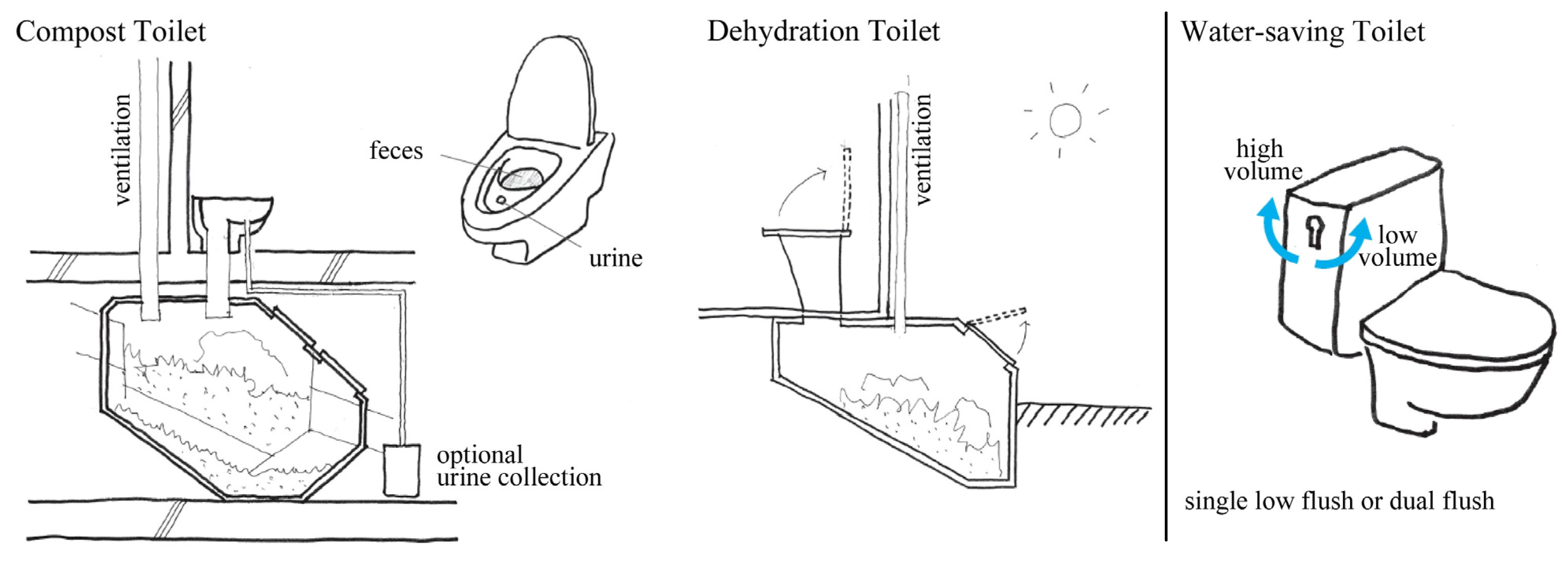
3.1.2. Taps and Showerheads

3.1.3. Household Appliances
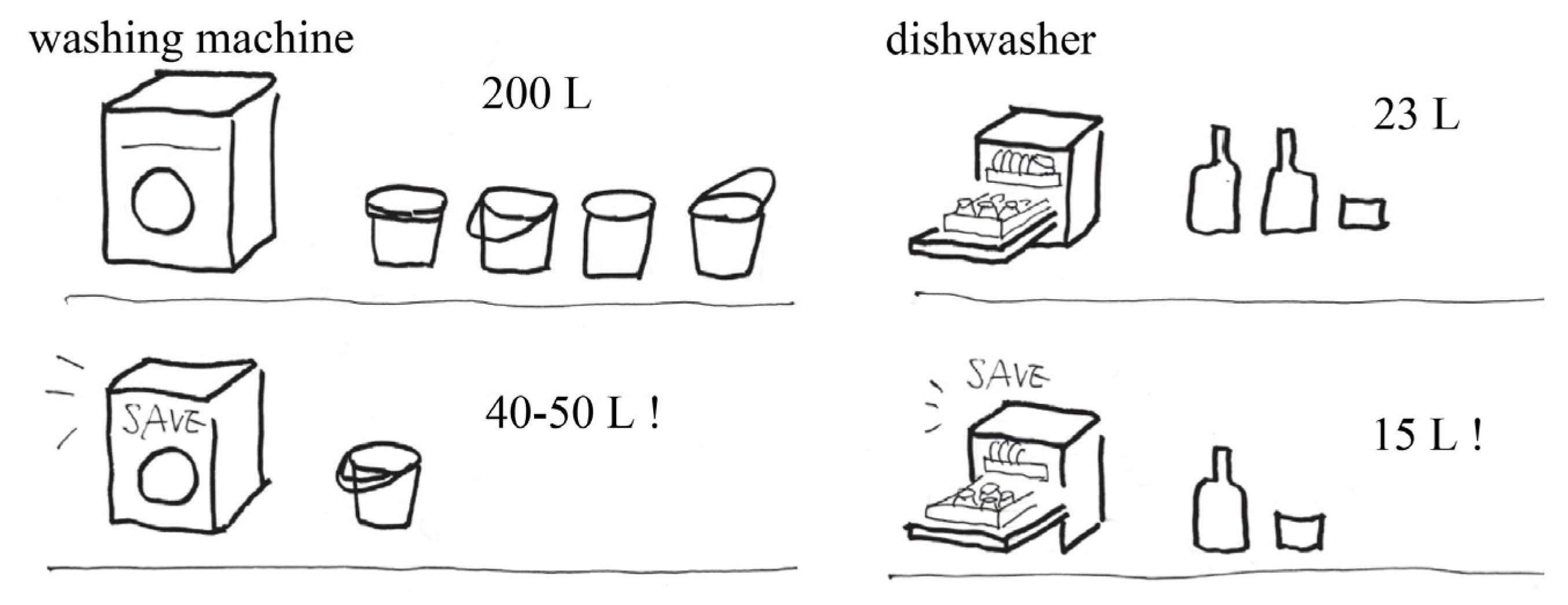
3.1.4. Alternative Water Resources for Increasing Water Availability
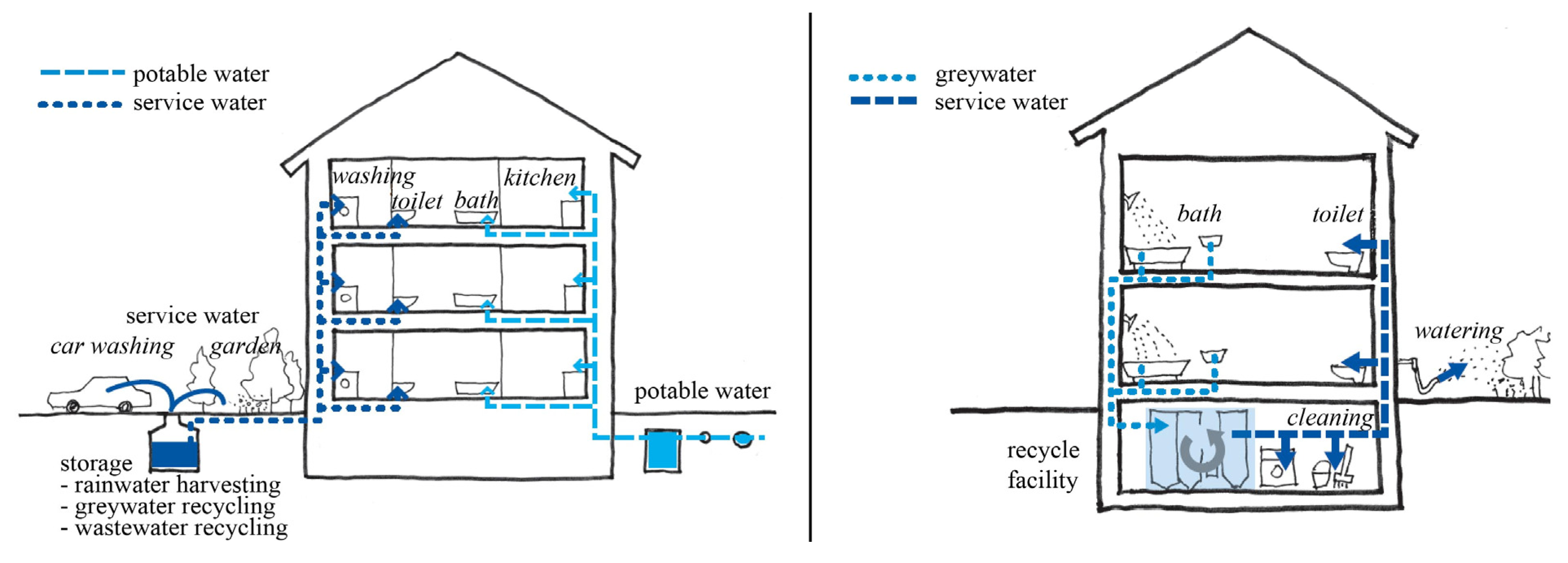
3.1.5. Example of the Potential of Drinking Water Demand Reduction by the Application of ESTs
3.2. Calculating Domestic Water Use and Achievable Savings
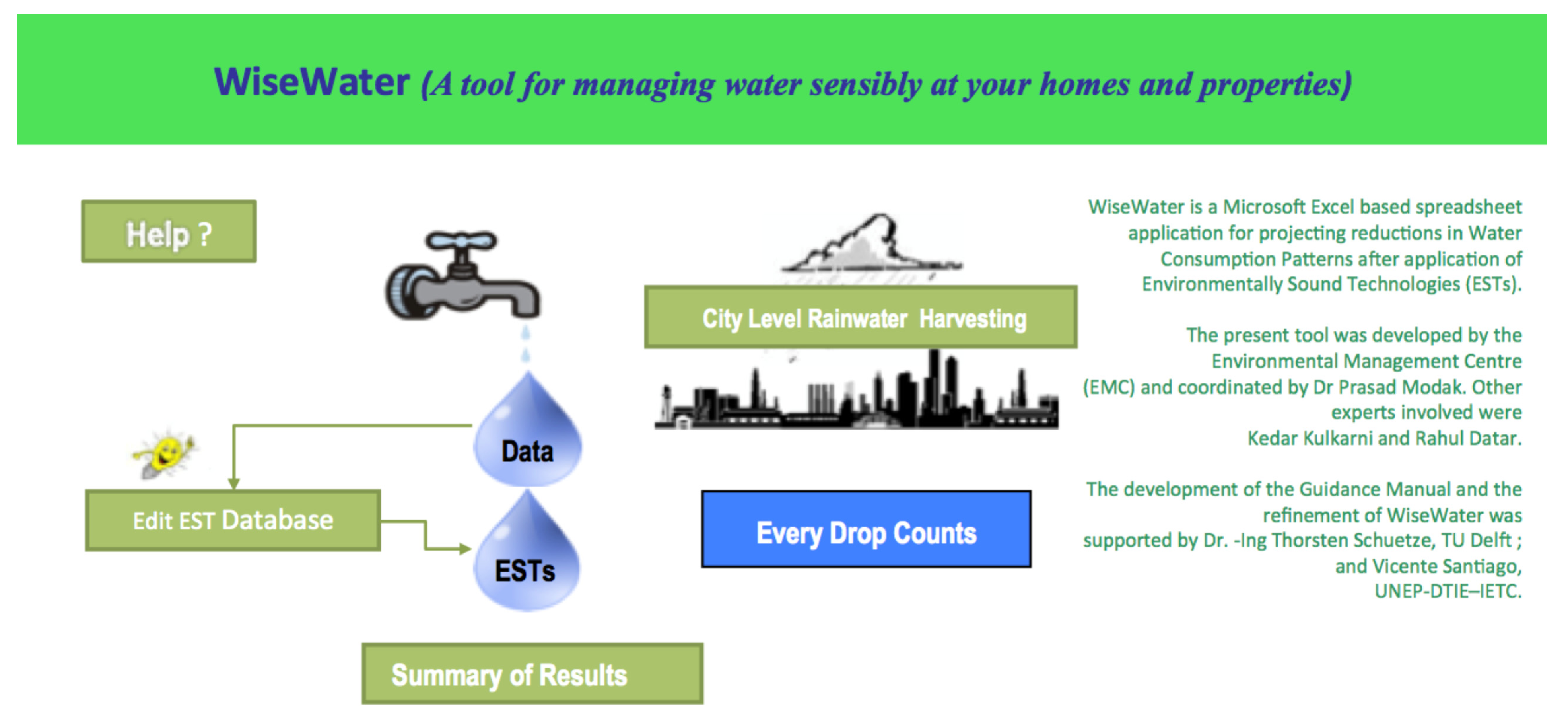
3.2.1. Data and Base Water Consumption
3.2.1.1. Water Consumption at the Household Level
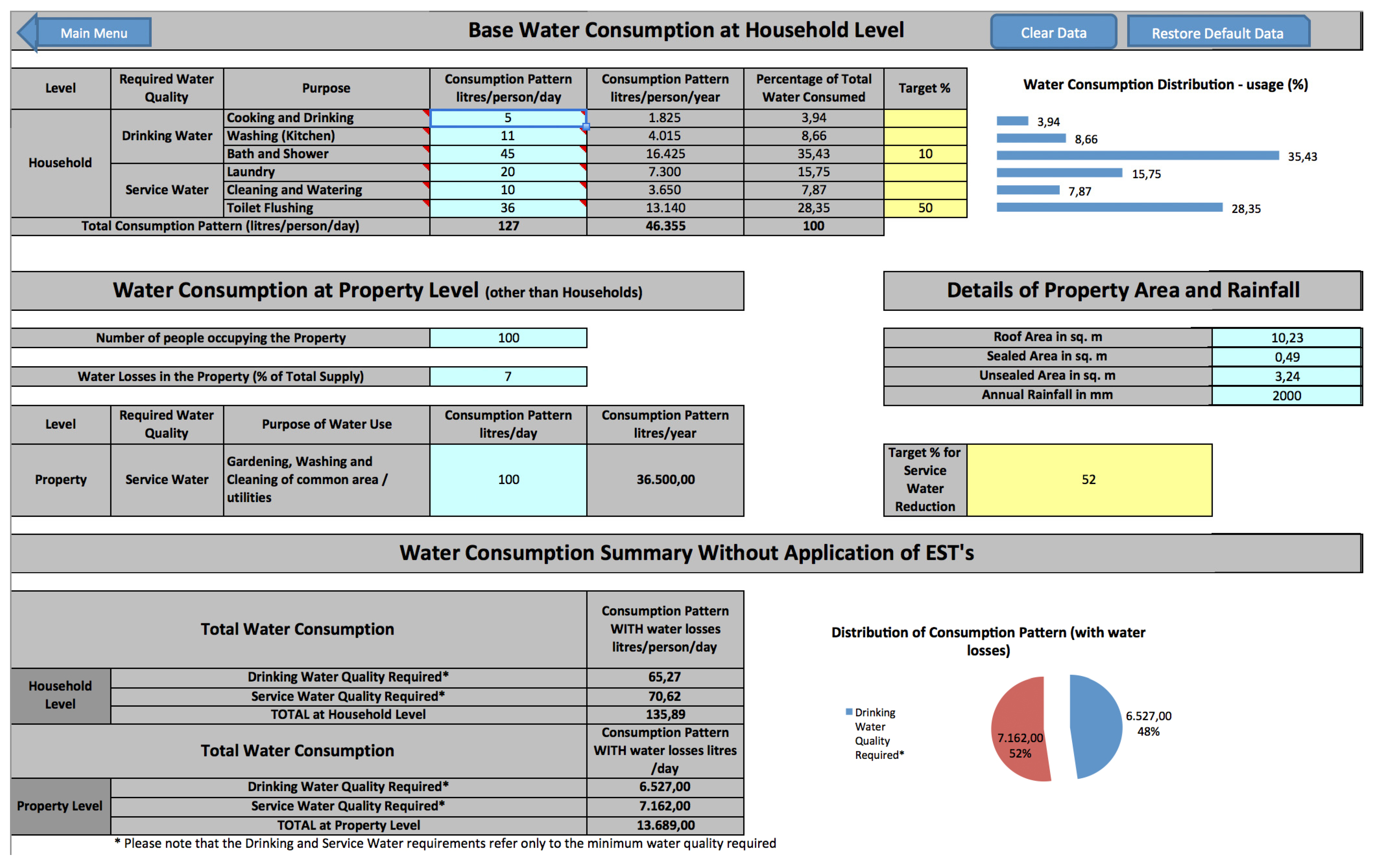
3.2.1.2. Water Consumption at the Property Level
3.2.1.3. Summary of Water Consumption at the Household and Property Level
3.2.2. Application of Environmentally Sound Technologies (ESTs)
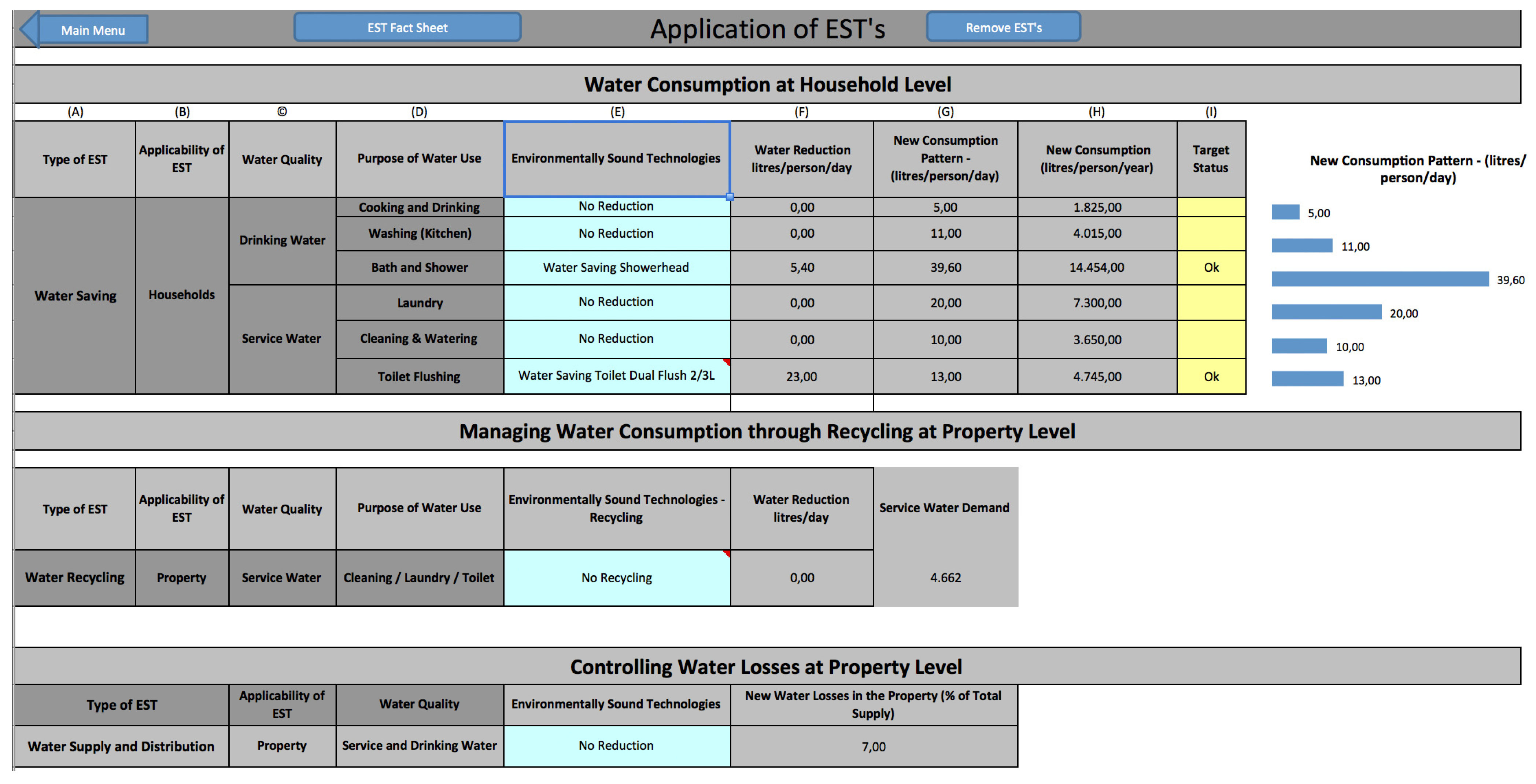
3.2.2.1. Technology Factsheets
3.2.2.2. Wise water and Water Savings
3.2.2.3. Water Recycling Technologies
3.2.2.4. Rainwater Harvesting Potential
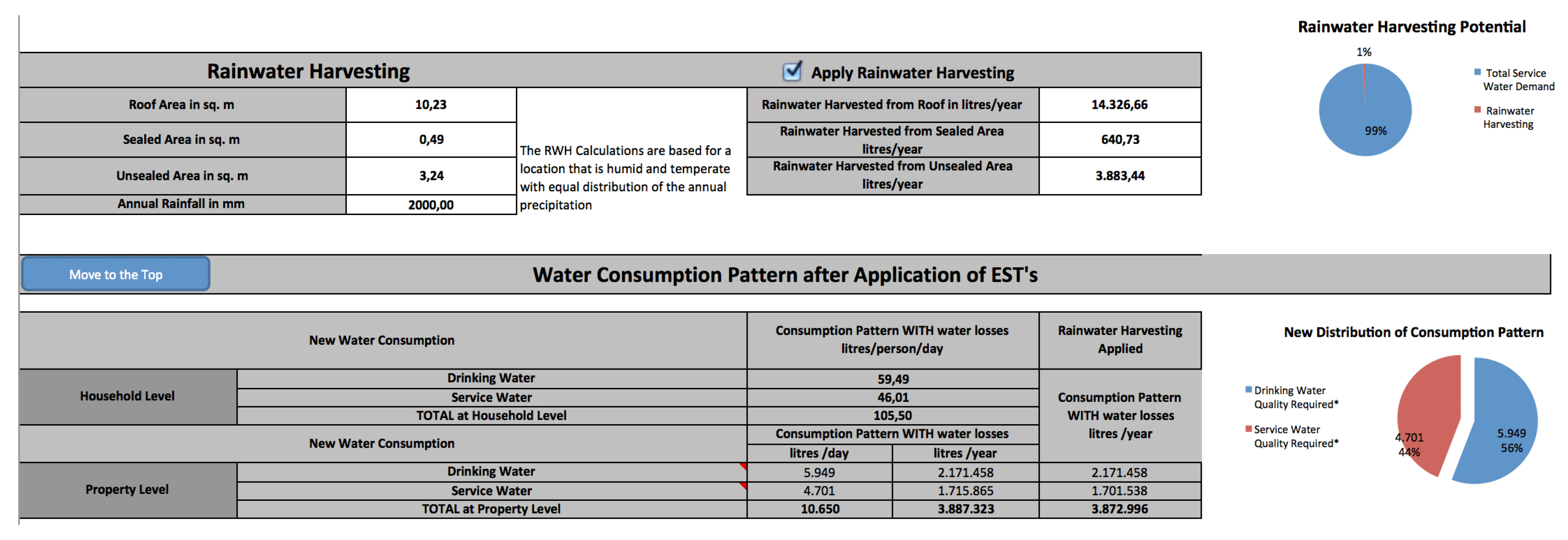
3.2.2.5. Water Consumption Pattern after Application of ESTs
3.2.2.6. Water Footprint and Freshwater Dependency
3.2.3. Summary and Rainwater Harvesting and Management Potential at the City Level
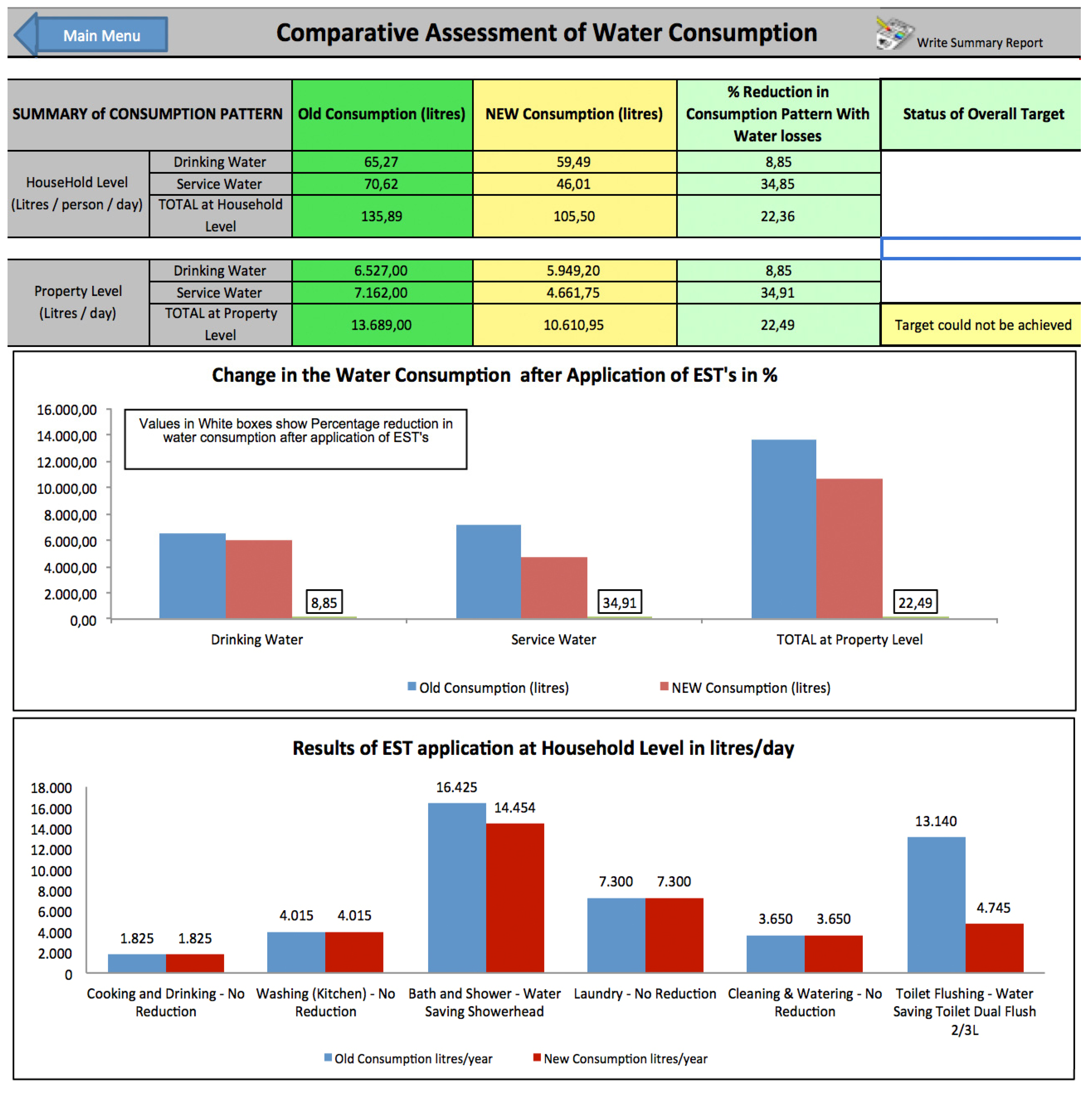

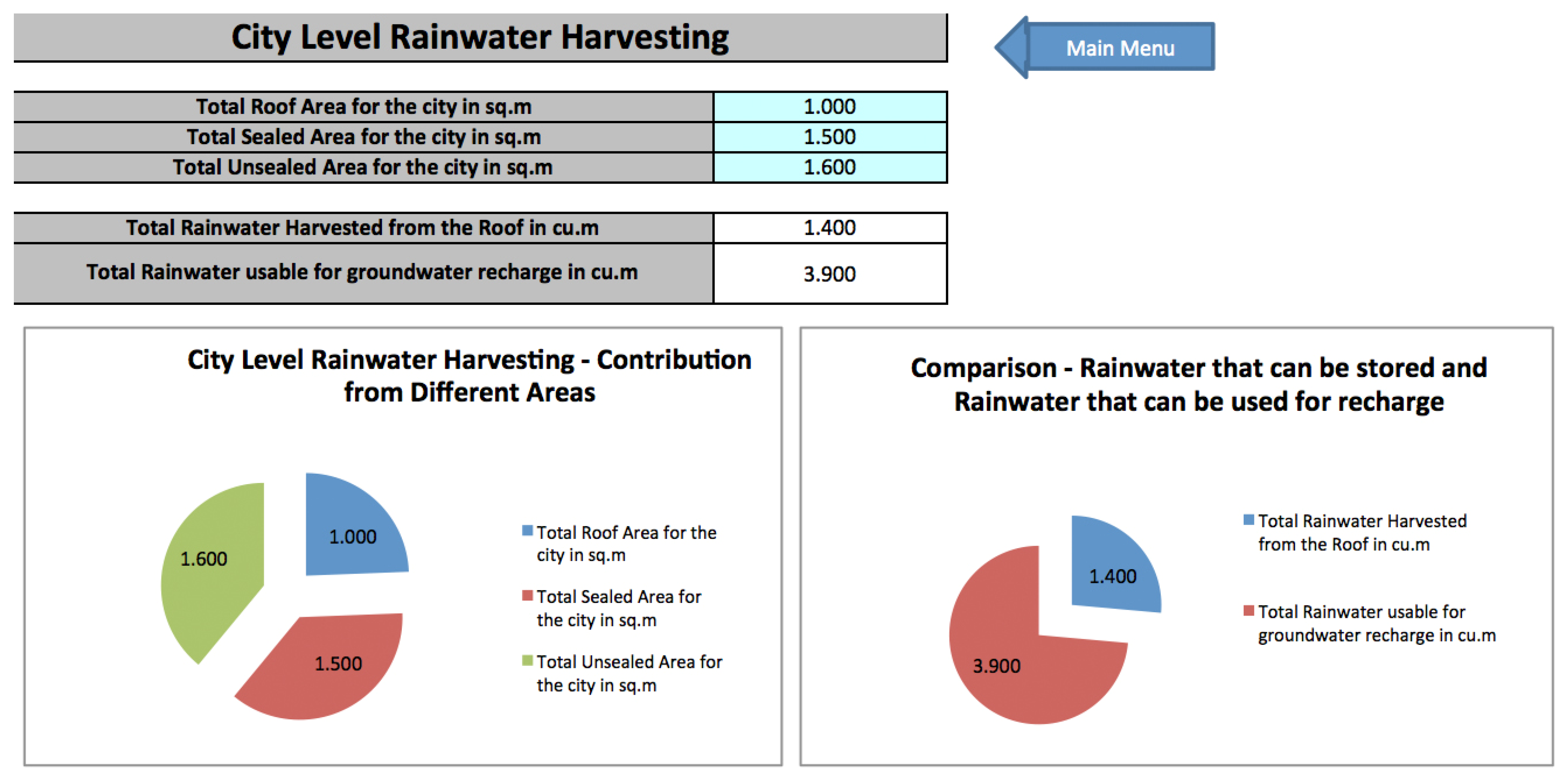
3.2.4. Examples of Rainwater Harvesting and Management Potential at the City Level
3.2.4.1. Rainwater Harvesting and Management Potential for Seoul, Republic of Korea (Table 2)
| Component | Roof non greened | Surface sealed | Surface non sealed | Total |
|---|---|---|---|---|
| Area (m2) | 102,600,000 | 296,450,000 | 205,700,000 | 604,750,000 |
| Area (Proportion of total) | 17% | 49% | 34% | 100% |
| Rainfall (m3/year) | 131,533,200 | 380,048,900 | 263,707,400 | 775,289,500 |
| Runoff coefficient | 0.7 | 0.6 | 0.55 | |
| Potential RWH (m3/year) | 92,073,240 | 228,029,340 | 145,039,070 | 465,141,650 |
| DWD domestic standard (m3/year) | 867,633,973 | |||
| Proportion potential RWH of DWD domestic standard | 10.6% | 26.3% | 16.7% | 53.6% |
| DWD domestic water saving (m3/year) | 417,749,691 | |||
| Proportion potential RWH of DWD domestic water saving | 22% | 54.6% | 34.7% | 113% |
3.2.4.2. Rainwater Harvesting and Management Potential for Hamburg, Germany (Table 3)
| Component | Roof non greened | Surface sealed | Surface non sealed | Total |
|---|---|---|---|---|
| Area (m2) | 37,500,000 | 150,000,000 | 202,500,000 | 390,000,000 |
| Area (Proportion of total) | 10% | 38% | 52% | 100% |
| Rainfall (m3/year) | 26,775,000 | 107,100,000 | 144,585,000 | 278,460,000 |
| Runoff coefficient | 0.7 | 0.6 | 0.55 | |
| Potential RWH (m3/year) | 18,742,500 | 64,260,000 | 79,521,750 | 162,524,250 |
| DWD domestic standard (m3/year) | 78,922,256 | |||
| Proportion potential RWH of DWD domestic standard | 23.7% | 81.4% | 100.8% | 205.9% |
| DWD domestic water saving (m3/year) | 39,461,128 | |||
| Proportion potential RWH of DWD domestic water saving | 47.5% | 162.8% | 201.5% | 411.9% |
4. Conclusions and Outlook
Acknowledgments
Conflict of Interest
References
- Hutson, S.S.; Barber, N.L.; Kenny, J.F.; Linsey, K.S.; Lumia, D.S.; Maupin, M.A. Estimated Use of Water in the United States in 2000; U.S. Geological Survey: Reston, VA, USA, 2004. [Google Scholar]
- Environmental Protection Agency Web Page, Water supply in the U.S. Available online: http://www.epa.gov/WaterSense/pubs/supply.html (accessed on 19 December 2012).
- Graveland, C.; Baas, K. Savings in Groundwater and Tap Water Use. Available online: http://www.cbs.nl/en-GB/menu/themas/natuur-milieu/publicaties/artikelen/archief/2011/2011-3349-wm.htm (accessed on 27 July 2013).
- Schuetze, T. Dezentrale Wassersysteme im Wohnungsbau internationaler Großstädte am Beispiel der Städte Hamburg in Deutschland und Seoul in Süd-Korea; [in German]; Books on Demand: Norderstedt, Germany, 2005. [Google Scholar]
- Core Writing Team; Pachauri, R.K.; Reisinger, A. Climate Change 2007: Synthesis Report; Intergovernmental Panel on Climate Change: Geneva, Switzerland, 2007. [Google Scholar]
- UN-Habitat, Water and Sanitation in the World’s Cities: Local Action for Global Goals; UN-Habitat: London, UK, 2003.
- Schuetze, T.; Tjallingi, S.P.; Correlje, A.; Ryu, M.; Graaf, R.; van der Ven, F. Every Drop Counts: Environmentally Sound Technologies for Urban and Domestic Water Use Efficiency, 1st ed.; United Nations Environment Programme: Nairobi, Kenya, 2008. [Google Scholar]
- EMC—Environmental Management Centre, Wise Water—A Microsoft ExcelTM Based Spreadsheet Application, 1st ed.; UNEP—United Nations Environment Programme: Nairobi, Kenya, 2008.
- Seoul Metropolitan Government, Seoul Water Works Report 2002; Seoul Metropolitan Government: Seoul, Korea, 2003.
- Hamburger Wasserwerke HWW, Rohwasserförderung 2001; [in German]; Hamburger Wasserwerke HWW: Hamburg, Germany, 2002.
- Foekema, H.; van Thiel, L.; Lettinga, B. Watergebruik Thuis 2007; [in Dutch]; Vewin—Vereniging van waterbedrijven in Nederland: Amsterdam, The Netherlands, 2008. [Google Scholar]
- Demirir, M.; Seelig, R. Eine vergleichende Untersuchung über die Spüleigenschaften ausgewählter Klosettbecken für öffentliche Sanitäranlagen; [in German]; Laboratory for Sanitation Technology, University of Applied Sciences Gelsenkirchen: Gelsenkirchen, Germany, 2000. [Google Scholar]
- Harrison, J. UA Study Shows Leaks in Conservation Theory Behind Low-Flow Toilets. Available online: http://uanews.org/node/3810 (accessed on 16 February 2013).
- Kamiya, H. Aim of “AIJ Guideline for RWH” and Practical Case Study. In Proceedings of the 3rd IWA Rainwater Harvesting Management International Conference, Goseong County, Korea, 20-24 May 2012; International Water Association Gyeongnam: Goseong County, Korea, 2012; pp. 77–79. [Google Scholar]
- Ward, S.L. Rainwater Harvesting in the UK: A Strategic Framework to Enable Transition from Novel to Mainstream. Ph.D. Thesis, University of Exeter, Exeter, UK, 27 April 2010. [Google Scholar]
- Marsalek, J. Rainwater Harvesting in Canada and the USA: Policies and Regulation. In Proceedings of the 3rd IWA Rainwater Harvesting Management International Conference, Goseong County, Korea, 20–24 May 2012; International Water Association: Goseong County, Korea, 2012; pp. 80–82. [Google Scholar]
- Kim, R. Rainwater Management Policy and Regulation in Korea. In Proceedings of the 3rd IWA Rainwater Harvesting Management International Conference, Goseong County, Korea, 20–24 May 2012; International Water Association: Goseong County, Korea, 2012; pp. 87–88. [Google Scholar]
- Liaw, C.-H. Integrating Rainwater into Stormwater Management in Metropolitean Taipei. In Proceedings of the 3rd IWA Rainwater Harvesting Management International Conference, Goseong County, Korea, 20–24 May 2012; International Water Association: Goseong County, Korea, 2012; pp. 83–85. [Google Scholar]
- Vlaamse Milieumaatschappij. Waterwegwijzer Bouwen en Verbouwen; [in Flemish] Building Code by the Ministry of Environment—Vlarem II (Article 6.2.2.1.2.). Vlaamse Milieumaatschappij: Brussels, Belgium, 2010. Available online: http://www.vmm.be/water/waterwegwijzerbouwen (accessed on 26 July 2013).
- DIN—Deutsches Institut fuer Normung e.V, DIN 1989-1 Rainwater Harvesting Systems; DIN: Berlin, Germany, 2002.
- König, K.W. The Rainwater Technology Handbook: Rainharvesting in Building; Wilo-Brain: Dortmund, Germany, 2001. [Google Scholar]
- Lange, J.; Otterpohl, R. Abwasser—Handbuch zu einer Zukunftsfähigen Wasserwirtschaft; [in German]; Mall: Pfohren, Germany, 2000. [Google Scholar]
- Jiménez, B. Turning brown water into green produce: Wastewater reuse in 22 Nicaraguan cities. J. Water Reuse Desalin. 2011, 1, 185–201. [Google Scholar] [CrossRef]
- Jiménez, B.; Asano, T. Water Reclamation and Reuse around the World. In Water Reuse: An International Survey of Current Practice, Issues and Needs; Jiménez, B., Asano, T., Eds.; IWAP: London, UK, 2008; pp. 3–26. [Google Scholar]
- Seoul Metropolitan Government Web Page. Energy Saving News. Available online: http://english.seoul.go.kr/gtk/news/energy_view.php?idx=18995&cPage=3& (accessed on 27 July 2013).
- Seoul Metropolitan Government, The Present Situation of Habitats in Seoul and the Demand for Ecological City Development; Seoul Metropolitan Government: Seoul, Korea, 2000.
- Seoul Metropolitan Government Web Page. Facts. Available online: http://english.seoul.go.kr/gtk/about/fact.php (accessed on 27 July 2013).
- Umweltbehörde Hamburg, Umweltatlas Hamburg 1997; Umweltbehörde Hamburg: Hamburg, Germany, 1997.
- Global Water Partnership Technical Advisory Committee, Integrated Water Resource Management; Global Water Partnership: Stockholm, Sweden, 2000; Volume 4.
- Durchschlag, A.; Hartel, L.; Hatwig, P.; Kaselow, M.; Kollatsch, D.; Otterpohl, R.; Schwentner, G. Joint consideration of combined sewerage and wastewater treatment plants. Water Sci. Technol. 1992, 26, 1125–1134. [Google Scholar] [CrossRef]
- Rauch, W. Some General Aspects on Modelling Integrated Urban Drainage Systems. In Proceedings of the Impact of Urban Runoff on Wastewater Treatment Plants and Receiving Waters, 9th European Junior Scientist Workshop, Kilve Somerset, UK, 9–13 April 1996; Schuetze, M., Ed.; Foundation for Water Research: Buckinghamshire, UK, 1996; pp. 79–84. [Google Scholar]
- Schuetze, M.R. Integrated Simulation and Optimum Control of the Urban Wastewater System. Ph.D. and D.I.C. Thesis, Department of Civil Engineering, Imperial College, University of London, London, UK, 1998. [Google Scholar]
- Schuetze, T.; van Loosdrecht, M.M. Urine Separation for Sustainable Urban Water Management. In Water Infrastructure for Sustainable Communities: China and the World; Hao, X., Novotny, V., Nelson, V., Eds.; IWA Publishing: London, UK, 2010; pp. 213–225. [Google Scholar]
- UNESCO-IHP, Capacity Building for Ecological Sanitation; UNESCO-IHP: Paris, France, 2006.
- Lüthi, C.; Panesar, A.; Schuetze, T.; Norström, A.; McConville, J.; Parkinson, J.; Saywell, D.; Ingle, R. Sustainable Sanitation in Cities—A Framework for Action, 1st ed.; Papiroz Publishing House: The Hague, The Netherlands, 2011. [Google Scholar]
© 2013 by the authors; licensee MDPI, Basel, Switzerland. This article is an open access article distributed under the terms and conditions of the Creative Commons Attribution license (http://creativecommons.org/licenses/by/3.0/).
Share and Cite
Schuetze, T.; Santiago-Fandiño, V. Quantitative Assessment of Water Use Efficiency in Urban and Domestic Buildings. Water 2013, 5, 1172-1193. https://doi.org/10.3390/w5031172
Schuetze T, Santiago-Fandiño V. Quantitative Assessment of Water Use Efficiency in Urban and Domestic Buildings. Water. 2013; 5(3):1172-1193. https://doi.org/10.3390/w5031172
Chicago/Turabian StyleSchuetze, Thorsten, and Vicente Santiago-Fandiño. 2013. "Quantitative Assessment of Water Use Efficiency in Urban and Domestic Buildings" Water 5, no. 3: 1172-1193. https://doi.org/10.3390/w5031172





